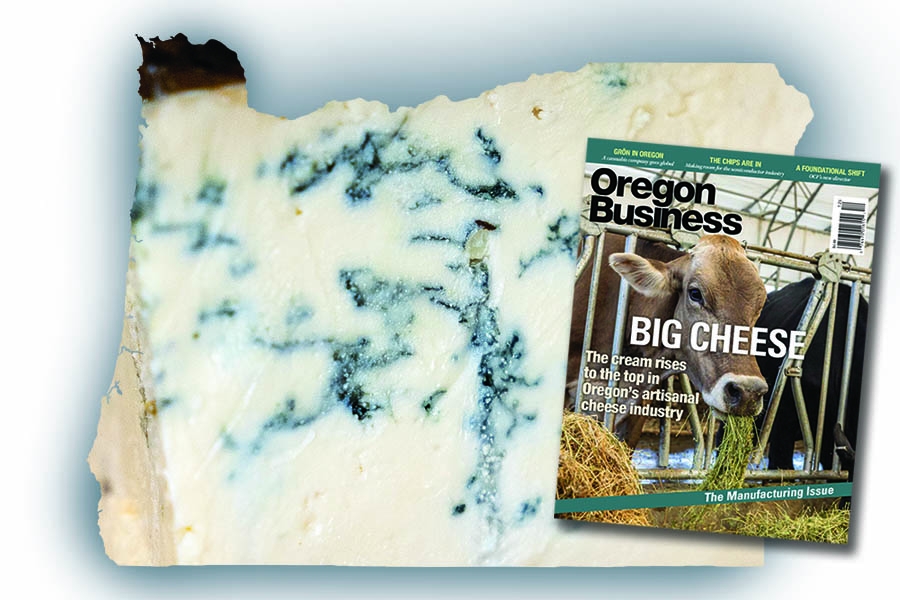Small compared to the nation’s other producers, Oregon’s cheese industry plays a big part in the state’s reputation for artisanal food. Here’s a look at how three cheesemakers survived the pandemic and are positioning themselves for an uncertain future.
At the start of the COVID-19 pandemic, Rogue Creamery — makers of the world-famous, award-winning Rogue River Blue cheese — faced a problem. Most of the world, swirling in the uncertainty brought by a new virus, hunkered down at home to “flatten the curve.”
But not Rogue.
“This is not the kind of business where you can just turn off the lights, stop production and come back in three weeks,” recalls Marguerite Merritt, Rogue Creamery’s cheese emissary and marketing manager. “Our cows produce milk every day. We need to keep producing cheese so that all that premium-quality organic milk doesn’t go to waste.”
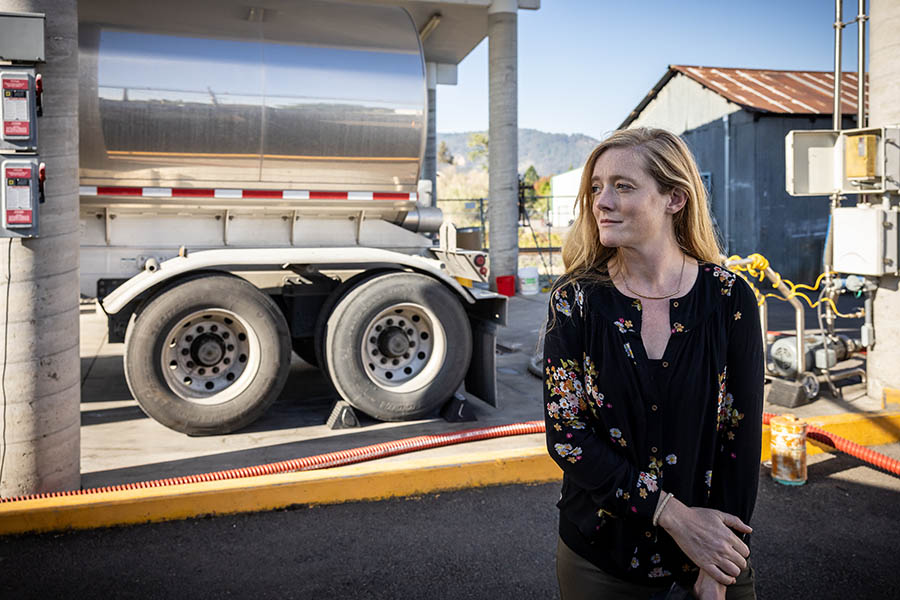 Rogue Creamery’s marketing manager and cheese emissary Marguerite Merritt. Photo by Jason E. Kaplan
Rogue Creamery’s marketing manager and cheese emissary Marguerite Merritt. Photo by Jason E. Kaplan
But who would buy it? Literally overnight, Rogue’s wholesale and food-service channels — representing nearly 80% of their pre-pandemic sales — disappeared. At the same time, a sudden wave of layoffs left huge numbers of Southern Oregonians unexpectedly food insecure. Local food banks strained under the increased demand.
To keep their staff employed and avoid wasting product, the cheesemakers at Rogue Creamery stepped in to feed their neighbors. But first they had to change their focus.
“Blue cheese is over 80% of our output. That’s not the most desirable protein to offer a food bank,” Merritt says. “However, we also make cheddar, which is versatile and universally loved.”
So the company flipped its script, producing a fresh cheddar for donation to ACCESS, the community action agency that manages Jackson County’s food banks. After six months of sending pallet after pallet out the door — “We were not even keeping track of amounts,” says Merritt — Rogue needed to pivot again.
“We were proud to do this, but in the long run, giving away our cheese was just not sustainable,” Merritt reports. With its wholesale business rebounding and e-commerce sales doubling, Rogue called on its customers for help. The creamery introduced Cheese Is Love cheddar, a three-year-old cheese the creamery had been storing for a special occasion in late 2020. For every pound of this extra-mature—and extra-expensive—cheddar sold, the company donates a pound of fresh cheddar to ACCESS. After two years, Rogue fans continue to buy the cheese and the creamery continues to give.
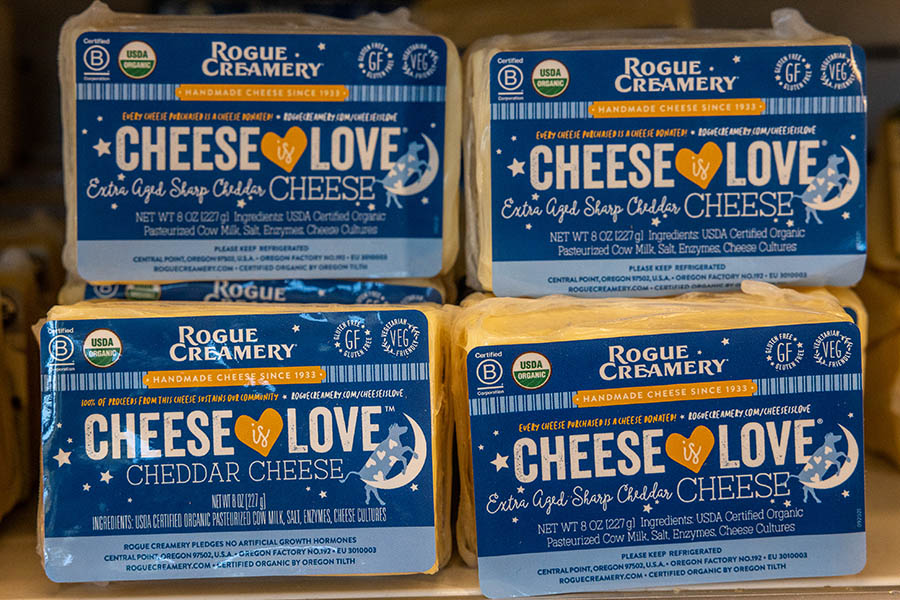
“We already received over 2,500 pounds of cheese this year,” reports ACCESS food programs director Marcee Champion.
Even with loyal customer support, the cheese business — from the smallest micro-creameries to the state’s biggest cheesemakers — suffered through months of pandemic disruptions. Wholesale markets dried up initially, then came roaring back. Restaurant sales disappeared with no hint of when they might return. E-commerce threw a vital lifeline to tech-savvy makers, and farmers markets helped other creameries survive.
Those challenges — along with new pandemic-caused stressors like the tight labor market, supply-chain disruptions and inflation — continue. Oregon’s cheesemakers must also deal with the existential threats of climate change, a shrinking pool of dairy farmers to provide milk and an increasing number of plant-based cheese substitutes nibbling at the margins. How can the state’s cheesemakers thrive?
Worth over $557 million in 2020, milk stands as Oregon’s fourth most valuable commodity, behind hay, cattle and greenhouse/nursery products. The state’s 184 licensed dairy farms produce about 2.6 billion pounds of milk a year, according to the Oregon Dairy and Nutrition Council. More than 30 different food processors, from the tiniest micro-creamery to the biggest players like Tillamook and Darigold (a Seattle-based cooperative of dairy owners from four Western states), churn that milk into the dairy products found in grocery coolers, specialty shops and farmers markets across the state. However, most of that value-added milk, nearly 80%, is exported nationally and abroad.
Still, Oregon’s cheese sector is just a tiny tidbit compared to Wisconsin, California or neighboring Idaho. Even Vermont produces more artisanal cheeses. Yet Oregon cheeses manage to consistently punch far above their weight. Rogue Creamery shocked the global industry when its Rogue River Blue took home the “World’s Best Blue Cheese” title at the World Cheese Awards in 2003. The product continues to impress, winning 2019’s World’s Best Cheese from the same organization.
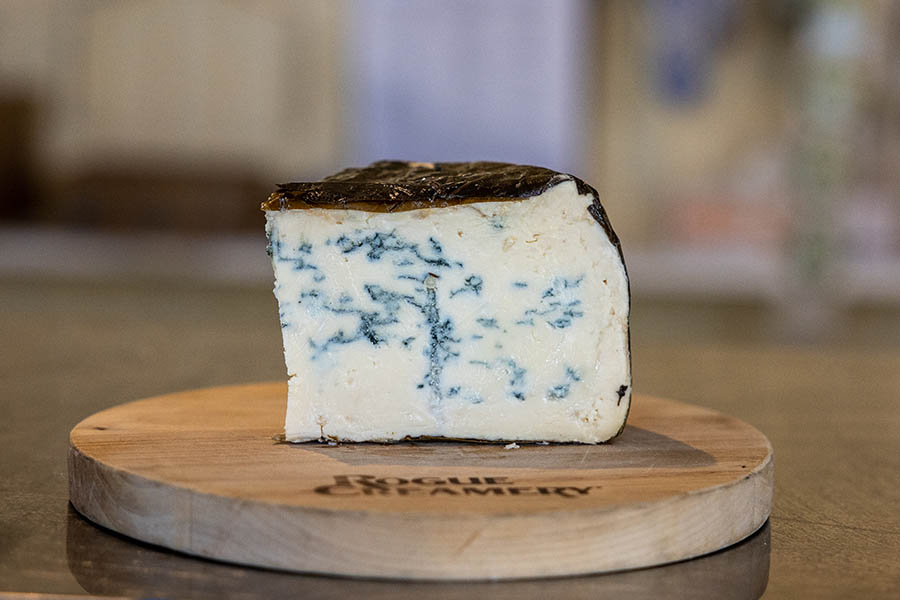 Rogue Creamery’s award-winning Rogue River Blue. Photo by Jason E. Kaplan
Rogue Creamery’s award-winning Rogue River Blue. Photo by Jason E. Kaplan
“I was in Europe in 2003 when Rogue’s win was announced,” recalls Lisbeth Goddik, who heads the Ph.D. department of food science and technology at Oregon State University. “It was a really big deal, just like when California wines beat out the French in 1976.”
Goddik explains that the win was particularly surprising considering how small Oregon’s cheese industry is: “Even Tillamook is just a medium-size company by comparison.”
This makes the persistence of farmstead operations through the pandemic that much more compelling. “I would say we are very small, minuscule, actually,” says Sarah Marcus, owner and cheesemaker of Briar Rose Creamery, with a laugh.
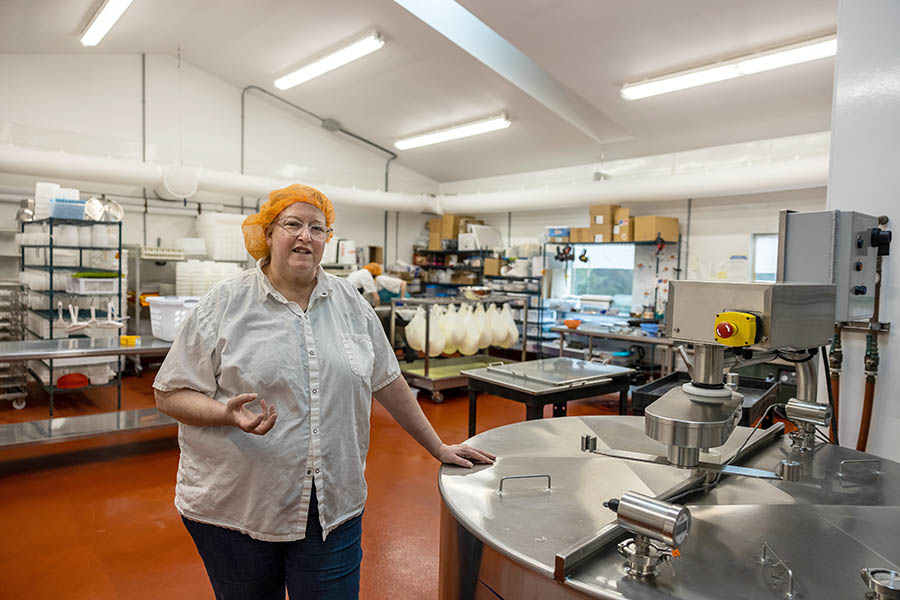 Owner and cheesemaker Sarah Marcus at Briar Rose Creamery in Dundee, Oregon. Photo by Jason E. Kaplan
Owner and cheesemaker Sarah Marcus at Briar Rose Creamery in Dundee, Oregon. Photo by Jason E. Kaplan
Founding Briar Rose in 2008, Marcus built a loyal following selling about half of her fresh and soft-ripened cheese to wineries and restaurants. The rest was shipped to farmers markets or distributed to specialty groceries in Portland, Seattle and California.
With restaurants and wineries shuttered at the start of the pandemic, Marcus leaned hard into her farmers market channels. The move strained her four full-time and two part-time employees: “Restaurants buy whole wheels of cheese. It takes a lot more labor to cut, weigh, wrap and label individual pieces,” she says.
The company’s February 2020 purchase of a second, larger vacuum-sealing machine proved serendipitous, she adds: “It paid for itself in one month!”
Marcus gave e-commerce a try as well but learned quickly that her soft, fresh cheeses do not stand up well to unpredictable shipping schedules and delays.
Conversely, Rogue Creamery enjoyed a huge bump in e-commerce sales. The creamery moved just 12% of its cheese via e-commerce in 2019. By the height of Covid disruptions, that number grew to 25% and is forecasted to continue at the level through 2022.
Marcus, however, had no interest in building and maintaining a robust online-sales platform. “There are only so many hours in the day,” she says. “Plus, the grocery business came roaring back quickly.”
The Oregon Cheese Guild can take partial credit for the fast rebound of cheese sales at grocery stores. Representing 22 creameries, the Guild negotiated with key distributors and retailers — like New Seasons, Market of Choice, Zupan’s and Whole Foods — to cut their margins while paying cheesemakers full price for product. This cushioned creameries while they reshuffled and retooled.
“Every partner we reached out to agreed,” says the Guild’s executive director, Katie Bray.
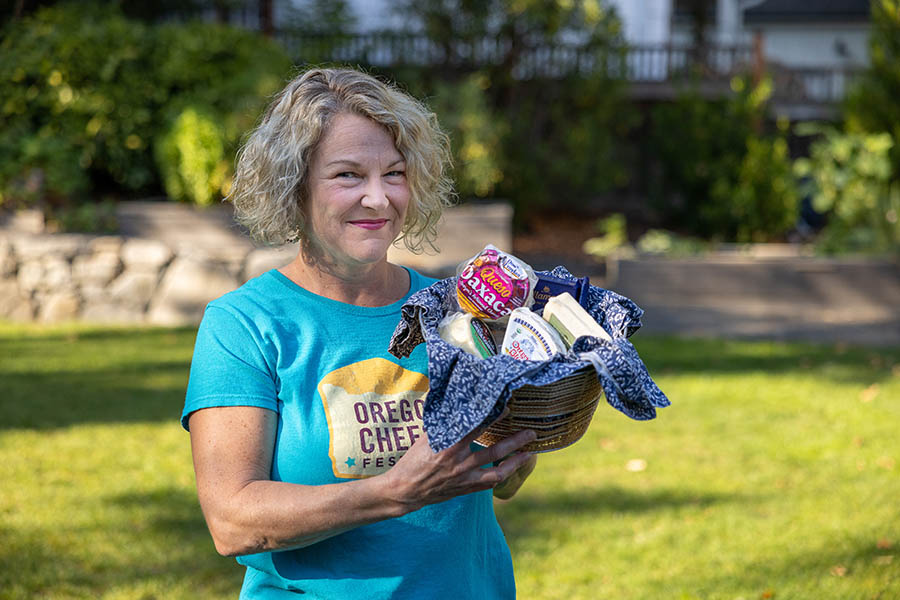 Katie Bray, executive director of the Oregon Cheese Guild. Photo by Jason E. Kaplan.
Katie Bray, executive director of the Oregon Cheese Guild. Photo by Jason E. Kaplan.
Creameries that made packaging investments in 2020 continue to benefit as the restaurant business still looks anemic. “Wineries came back stronger than ever for us,” says Marcus, “but restaurants still lag.”
Rogue also reports a continued steep decline in food-service sales, falling from 48% of the creamery’s business to just 16% in 2022.
“We are pursuing ways to regrow that side of the business,” says Merritt. Strategies include making the cheese more financially accessible for restaurateurs and offering bags of precrumbled product.
Tillamook, however, is seeing the opposite. While its food-service business was relatively small compared to its retail business, according to Patrick Criteser, president and CEO of the Tillamook County Creamery Association, the company continued to build relationships with key distributors across the country.
“This has paid dividends as restaurants and food-service businesses open back up,” he wrote via email. “We now have much broader food-service distribution for Tillamook cheese than we previously had.”
(Criteser didn’t offer any numbers for the cheese side of the business but did call 2022 a pivotal year for Tillamook ice cream on the food-service front. “We entered a partnership with Dot Foods, the largest food-service redistributor in the country, to expand our 3-gallon ice cream footprint nationally, which has resulted in a 60% year-over-year increase in food-service sales for Tillamook ice cream,” he wrote. “We also have recently partnered with Six Flags to be the Official Scoopable Ice Cream of their theme and water parks.”)
While Oregon’s cheesemakers found ways to continue making and selling product during the pandemic and beyond, other stressors remain. Perhaps most pressing is the continued and accelerating loss of Grade A cow milk dairy producers. In 2021 there were approximately 184 licensed operations, according to the Oregon Dairy and Nutrition Council — down from 326 in 1998. The numbers translate into Oregon losing about six dairy farms per year to retirement, lack of succession planning and consolidation.
This trend is not limited to Oregon. The number of licensed U.S. dairy herds fell by more than half between 2002 and 2019, with an accelerating rate of decline in 2018 and 2019, according to a report by the U.S. Department of Agriculture. The national reasons are the same: aging farmers, lower milk prices, higher feed costs and the advantages of consolidation.
Rogue Creamery insulated itself from this drift by vertically integrating its own farm into the business. In 2014 the company bought a 68-acre dairy in Grants Pass, and two years later, the 225-head operation was putting out about 6,000 pounds of USDA Oregon Tilth Certified Organic milk a day for the creamery to process.
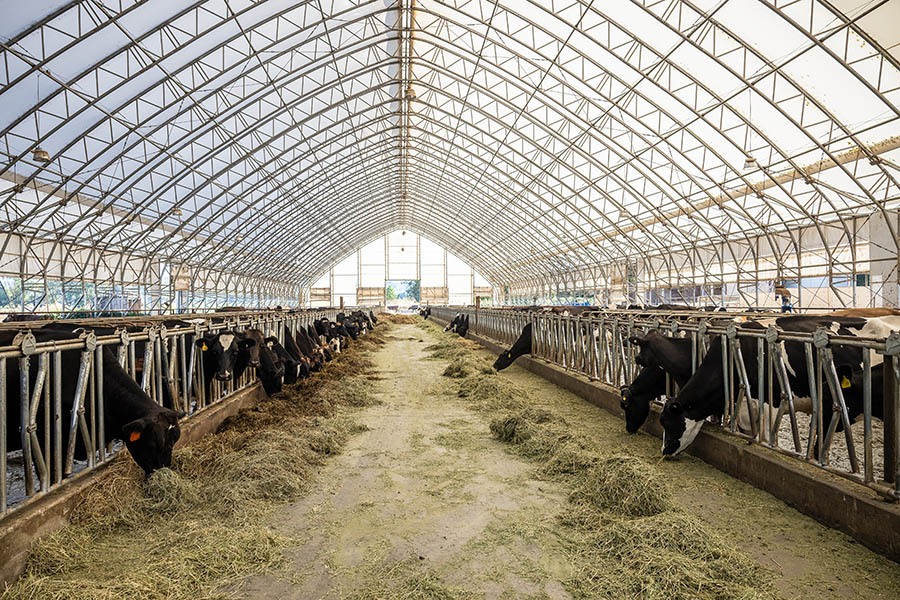 Cows feed at Rogue Creamery’s dairy farm in Grants Pass, Oregon. Photo by Jason E. Kaplan
Cows feed at Rogue Creamery’s dairy farm in Grants Pass, Oregon. Photo by Jason E. Kaplan
Other cheesemakers, however, may face a future scrambling for available milk. Briar Rose’s Marcus is not too concerned for now.
“I’ll still be able to buy milk, but in the future, maybe not from the farms I buy from now,” she says. Data from the U.S. Department of Agriculture bear this out: The United States produced 226.3 billion pounds of milk in 2021 versus 208 billion in 2015. So there’s plenty of milk for cheese producers to buy, if a dwindling number of farmers to buy from.
But even laid-back Marcus admits that labor shortages made running her business harder. “It’s a bit more stable than it was during the pandemic, but it’s still challenging to find qualified individuals,” she says. “The work is very labor intensive, but you also need to use your brain.”
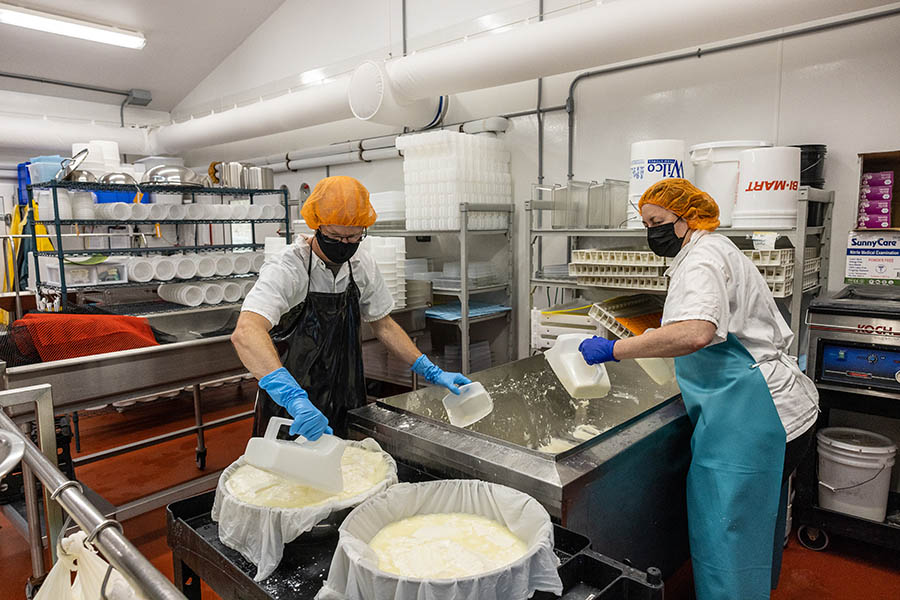 Cheesemakers at work at Briar Rose Creamery in Dundee, Oregon. Photo by Jason E. Kaplan
Cheesemakers at work at Briar Rose Creamery in Dundee, Oregon. Photo by Jason E. Kaplan
Merritt reports that Rogue had many employees leave during COVID, despite being named number one in the 2022 Oregon Business list of 100 Best Green Workplaces in Oregon. “Prior to COVID, we had a very low rate of employee turnover. During the last couple years, though, we’ve seen a large percentage of our workers switch industries, relocate to be nearer to their families, or move out of the area due to climate and fire concerns,” says Merritt.
These labor pains, combined with supply-chain woes that snarled packaging options, certainly slowed many of the state’s other cheesemakers. Bray, from The Oregon Cheese Guild, reports these factors kept the Guild from relaunching The Wedge—a farmers-market-style cheese festival held in Portland—in 2021 after a one-year hiatus.
“The public showed interest, and we found a great covered venue that offered good air circulation,” recalls Bray. “But we couldn’t find enough cheesemakers. Either they didn’t have enough product to sell or an available human body to work the booth.”
2022 was a different story. About 900 people attended The Wedge, sampling cheese and other artisan foods and beverages from 55 different vendors this September. That’s a big drop from the 1,800 attendees and 85 vendors present in 2019, but Bray reports enthusiastic feedback from participants and merchants.
Tillamook was also sampling at The Wedge. Far from artisanal, Tillamook County Creamery Association is one of the 50 largest dairy processors in North America, according to the trade publication Dairy Foods. The company straddles a fine line, leaning hard into its image of a homespun co-op of 80 family farmers tucked away on the Coast — while also being a big player that can boast 53% growth since 2019, topping $1 billion in retail sales in 2021.
Where does Tillamook get its milk? Look east to Threemile Canyon Farms, a mega-dairy operation in Boardman with some 33,000 cows. The certified B-Corporation insists that its award-winning, closed-loop mega-dairy is the way to bring better-tasting, higher-quality, authentic dairy to scale while still offering environmental protections.
“As a Certified B-Corp™, we’re committed to reducing our impact on the planet, which is why Tillamook County Creamery Association has aligned with the InnovationCenter for U.S. Dairy’s Stewardship Commitment to reach net-zero emissions by 2050, and this year we set an interim goal of 30% reduction in emissions by 2030 in our new Climate Action Plan,” wrote Criteser.
Criteser points to strategies to drive down total emissions like “investing in improvements in our facilities and fleet, and working with farmers to adopt sustainable practices on farms, like converting manure waste into clean energy — a practice that many Tillamook County Creamery Association farmer-owners and milk suppliers are adopting.”
Concern about that manure and the other environmental and animal welfare impacts of dairy production have a growing number of consumers looking to a new product for their cheese board: plant-based cheese products. Valued at $2.43 billion in 2021, the global plant-based cheese market is expected to expand at a compound annual growth rate of 12.6% from 2022 to 2030.
Only time will tell if plant-based cheeses will surpass real dairy offerings.
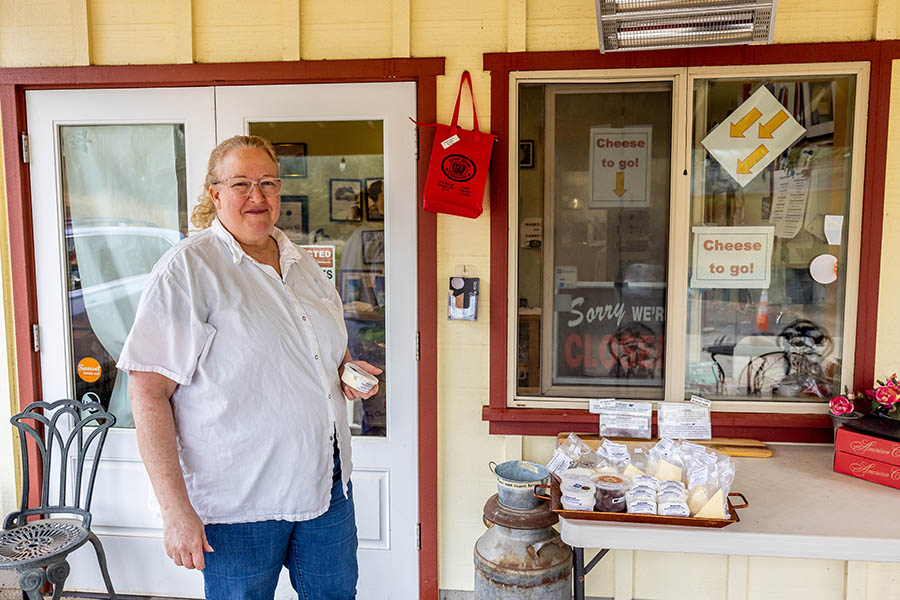 Sarah Marcus outside Briar Rose Creamery in Dundee, Oregon. Photo by Jason E. Kaplan
Sarah Marcus outside Briar Rose Creamery in Dundee, Oregon. Photo by Jason E. Kaplan
“It’s a trend in every sense of the word,” says Briar Rose’s Marcus.
Tillamook is betting on a different food trend: the willingness of consumers to spend more on specialty foods versus cheaper commodity offerings. As an example, Criteser points to coffee.
“The dollars spent on specialty coffee…30 years ago was just half the dollars spent on commodity coffee. Today specialty coffee is at least twice the market size of commodity coffee,” wrote Criteser. “We think there is a ton of growth opportunity, not necessarily in volume [of dairy] consumed but in the consumer’s willingness to pay for higher-quality offerings,” he wrote.
Another driver in dairy’s favor? A growing farm-to-table ethos that seems only stronger post-pandemic. Sarah Masoni, director of product and process development for OSU’s Food Innovation Center, reports reviewing 75 grant applications to Washington state’s Department of Agriculture for people wanting to build a more robust resident food infrastructure. “More and more, we’re seeing that people want to buy local,” she says.
Investing in a local food infrastructure sounds good, particularly after living through pandemic shortages. But small-scale artisanal food is, by definition, more expensive. There are plenty of people willing to pay more for the local choice—the “better” choice—for now. But with food costs rising, even the most discriminating gourmet may have to reassess what goes on their plate — and whether there is room for cheese.
To subscribe to Oregon Business, click here.


